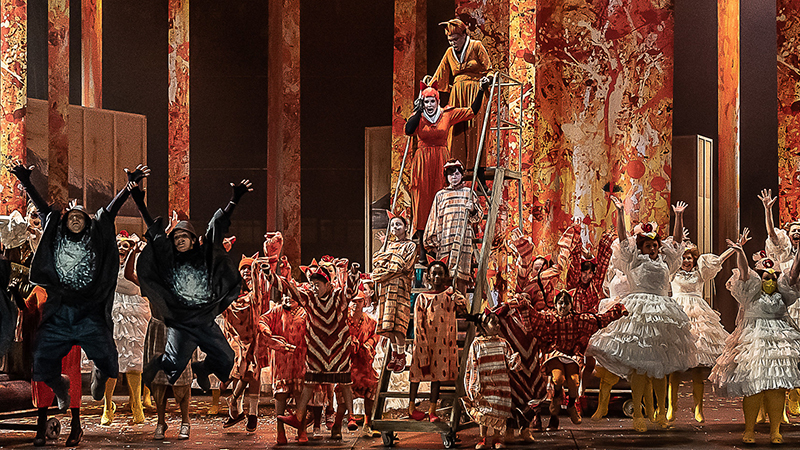-
10 Things to Know about THE CUNNING LITTLE VIXEN
By COC StaffPosted in 23/24 Season
A new production of Leoš Janáček’s bittersweet fable about a clever fox cub examines our relationship with the natural world—as well as the poignant beauty to be found in the cycle of life and death. Appearing at the COC for the first time in 25 years, this winter’s The Cunning Little Vixen is not to be missed!
Curious to learn more? Read on for 10 Things To Know about the opera and its composer.
Spoiler alert: the following content contains plot points that some audience members may not wish to know in advance!
BUY TICKETS
It started with a comic stripJanáček’s opera was inspired by a serialised novella by Rudolf Těsnohlídek, Liška Bystrouška (“The Cunning Vixen” or “The Sharp Vixen”—to echo her name, Sharp Ears), which was illustrated with comic-strip drawings of the vixen and other animals. Janáček adapted the light-hearted cartoon as the basis for a three-act operatic reflection on life and death—though comic moments still remain!Lonely hearts
Janáček’s unrequited adoration of the much younger and married Kamila Stösslová inspired him to base several operatic characters on her, including Sharp Ears in The Cunning Little Vixen. The hopelessness of them ever having a proper relationship—despite Janáček writing over 700 love letters to Stösslová—may have been the basis for some of the themes introduced in the third act, including the inescapability of death.A fairy tale—sort of
Featuring foxes, hens, a mosquito, frog, and other forest creatures in an opera was considered more than slightly unorthodox in Janáček’s day, and points to his experimental instincts. The subject matter of Vixen remains grounded in “real” life, however, from the natural setting to the show’s universal themes of love, grief, and parenthood.
An innovative opera
Janáček’s libretto is experimental in other ways—most notably by adapting ballet, mime, and orchestral interludes as part of the opera. Musically, Vixen draws on Romantic, folk, and Impressionist influences to present a playful and innovative score which continues to charm audiences a century after its original premiere.

Doing the researchLong before he composed The Cunning Little Vixen, Janáček was a pioneering collector of Moravian musical samples, responsible for making the first phonograph recordings of folk music from eastern Czechia and developing his own musical style based on the inflections and distinctive rhythms of local peasant dialects and songs. The folk influences in Vixen’s luminous score are easy to recognize and set it apart from most other operas of its time.
What does the fox say?Janáček was equally fascinated by animal sounds and kept extensive birdsong notations that helped inform the music of The Cunning Little Vixen. His “speech tunes” were designed to capture the melodies of human and animal communication and are partly responsible for giving the music of Vixen its distinctive quality.
In his own voiceOne of Janáček’s former students, the Czech conductor and composer Vilém Tauský, observed that Janáček’s own staccato speech rhythms are replicated in several of his operatic characters. Attending a performance of The Cunning Little Vixen may therefore be the best way to hear the voice of Janáček himself, as well as his music!
A late bloomer
Janáček was already in his sixties when his opera Jenůfa premiered in Prague to wide acclaim—the first of his works to win him significant recognition. The composer’s creative power continued unabated to the end of his life, with The Cunning Little Vixen premiering just four years before his death in 1928.
A fitting tribute
In August 1928, following an outing with Kamila Stösslová and her son, Janáček caught a chill which turned into pneumonia. He died several days later. At his request, music from the final scene of The Cunning Little Vixen was performed at his funeral.
If it ain’t broke…
Janáček’s professional collaborator Václav Talich later adjusted several of the composer’s scores, including the Suite he adapted from Act I of The Cunning Little Vixen. Claiming that it couldn’t be performed at the Prague National Theatre without being completely re-orchestrated, Talich’s rearrangement removed some of the more unusual musical elements and remained the standard for many years. Australian conductor Sir Charles Mackerras later restored the original scoring, rescuing the distinctive contrasts that make Janáček’s music so special.
The Cunning Little Vixen opens January 26 at the Four Seasons Centre for the Performing Arts!
BUY TICKETS
Photos: Clive Barda
